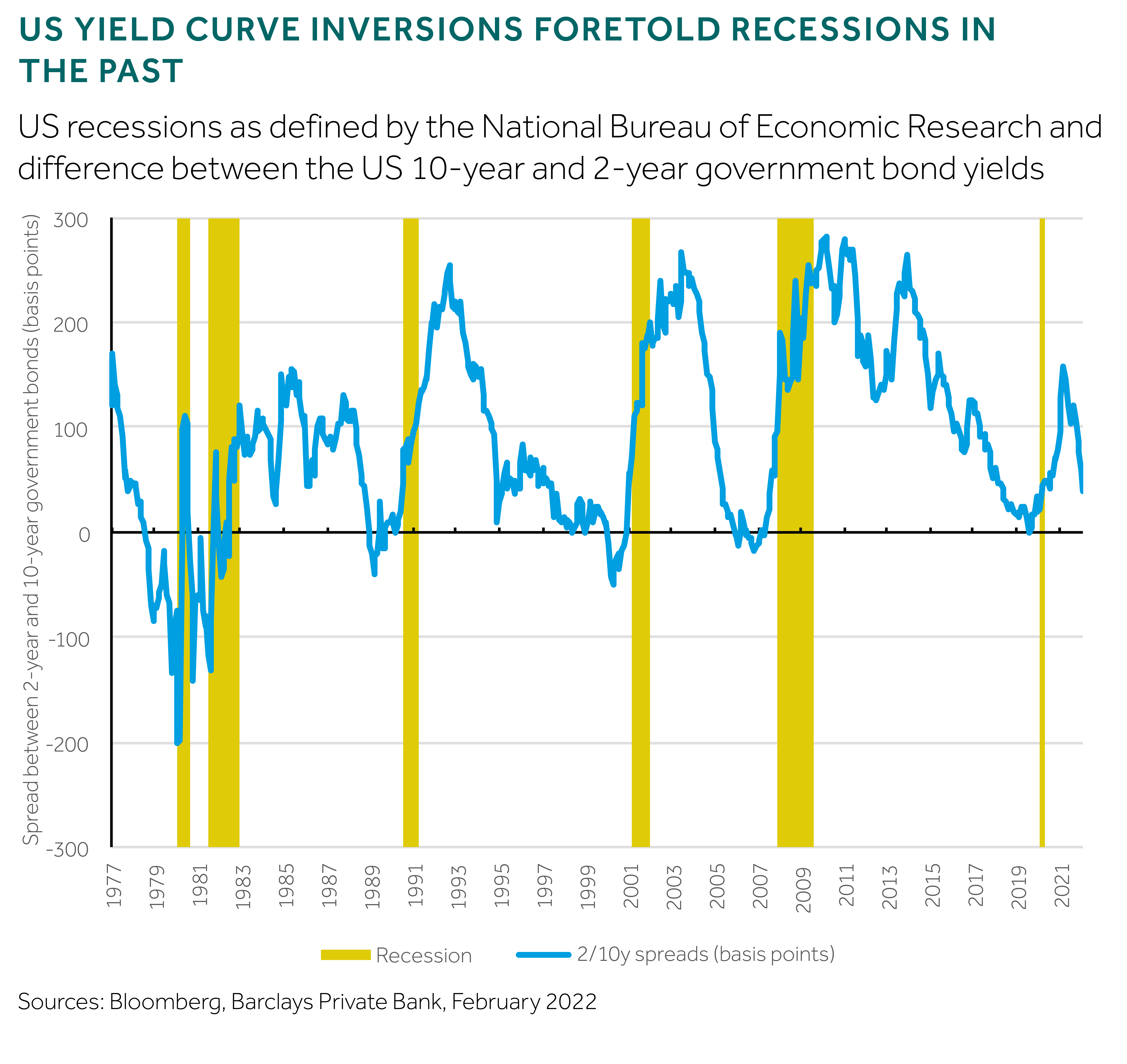As the US central bank eyes the end of its monetary largesse, bond yields rise, and geopolitical tensions increase, many investors are gripped by the prospect of another recession. However, timing one is tricky. Many go-to indicators for downturns may be losing their effectiveness. However, we believe that inflation will ease in many developed economies in the second half of the year, and the risk of a recession in the short term seems overblown.
In response to the coronavirus pandemic, the American economy saw a swift economic recovery last year following the sharp contraction in 2020. The markets’ views of the world, and its behaviour, have shifted quickly in the last three months to a mid-cycle scenario. The next stage (a late cycle) is usually followed by recession. While it seems too early to worry about a recession being on the horizon, the recent flattening of the US yield curve, often seen as an indicator of a downturn, raises questions.
A viable recession indicator
Historically, the yield curve has been a reliable leading indicator of an upcoming recession. Indeed, the last six American recessions started after the differential between the yield on the 10-year and the 2-year (the so-called “2/10”) US government bonds turned negative.
With a 2/10 spread around 50 basis points (bp), down from 150bp a year ago, concerns are emerging in financial markets. While we appear some way from an inversion, parts of the futures curve have nonetheless started to invert. If the curve continues to flatten, as the difference between short-term and long-term bonds narrows, recession calls will only multiply in our view.
Not a perfect crystal ball
While the US yield curve’s track record as a leading indicator of a recession is second to none, it is still imperfect. First, the time between when inversion and a period of three consecutive months of contraction (or a recession) begins can vary substantially. In the late 80’s, the curve first inverted in December 1988. The recession that followed started 18 months later. In the late 90’s, the curve briefly inverted in 1998, before steepening again and collapsing in early 2000. The “dot-com” recession officially started in March 2001, some three years after the first inversion.
Most recently, the curve inverted in August 2019 and there was a pandemic-led, “flash” recession between February and April 2020. Here, though, the recession was caused by an exogenous, health-related shock, and not a typical end to the business cycle. As such, we will never know if and when this would have happened without COVID-19.
The influence of central banks
Not only is the shape of the US yield curve becoming an imperfect timing signal for a recession, but it is increasingly influenced by factors that can weaken its predictive power. After the ballooning of the US Federal Reserve’s (Fed) balance sheet to $9 trillion in its asset-purchase programme, the central bank now owns around a fifth of the country’s debt. As a result, yields across the curve have been significantly distorted, and may not fully reflect the true shape of the US economy.
The power of central banks to distort yield curves is also evident in Europe. A study by the European Central Bank showed that central bank asset purchases lead to a flattening of the curve, since the yields of longer-term bonds tend to decline by more than those of short-term bonds.
Is a US downturn imminent?
As discussed earlier, the yield curve is a useful, but imperfect, tool to judge when a recession might strike. This is why investors tend to monitor a wider range of indicators. None is perfect, but, taken together, they can help build a better picture of where the US economy is headed.
Some of the most popular recession predictors include: the yield curve, real interest rates, recession probability models, and composites of leading indicators. The table shows that none of these is a source of concern, at this stage. This does not mean that a recession in the short term is impossible. It simply means that its probability is rather low.
| Indicator |
Trigger |
Level as of 28 Feb |
Level six months prior |
|---|
| US yield curve slope (10-year to 2-year Treasuries, bp) |
Negative |
40 |
110 |
| Real rates |
Positive |
-0.79% |
-1.03% |
| New York Fed recession model |
Above 20% |
6.0% |
18.9% |
| Leading indicators index |
Negative |
7.3 |
8.7 |
Low but increasing risk
While the risk of a recession is low, compared to six months ago, the risk has increased. This is predominantly driven by the Fed’s move to a gradual tightening of monetary policy, from an ultra-accommodative stance. As the US central bank moves to increase interest rates and shrink its balance sheet, there is a concern that the pace of hikes is too quick and the domestic economy starts to contract.
This is a scenario that is gaining traction in markets. In fact, the yield curve shows that in 2023, the Fed may be forced to cut interest rates again. While this could happen without a recession (a “soft landing”), the market is increasingly pricing in a policy mistake.
Stagflation versus recession
We expect the bears’ narrative to gradually evolve in one of two ways as we go into the summer. On one hand, “stagflation fears” similar to the one experienced in the second half of last year could re-emerge. This scenario is most likely to occur if inflation stays high (we think price increases will be elevated until the second half of the year), growth slows from elevated levels, and the Fed appears too prudent.
Such a scenario would be a decent backdrop for risk assets, especially if inflationary pressures moderate. On the other hand, talk of recession could dominate everyday discussions if the Fed is forced to aggressively combat inflation. Then, the curve would likely invert as more hikes are priced in on the short-end of the curve. This would be a much more challenging environment for investors.
Positioning for heightened uncertainty
Acknowledging the uncertainty created by the conflict in Ukraine, we believe maintaining composure is key to investors’ long-term success. As such, we stay invested and continue to prefer equities to bonds. Yet, there are challenges ahead, and volatility will likely remain elevated for the foreseeable future. This year’s increases in bond yields suggest that we are approaching levels where it may soon be worth locking in rates again.
In equities, the value/cyclical tilt we supported going into this year has played out well, but the opportunity is gradually shrinking and geopolitical tensions may add to the confusion. Short-term investors may need to be even more selective, while longer-term ones may want to start looking at quality and growth stocks again.


